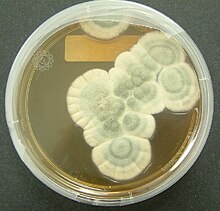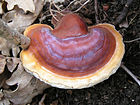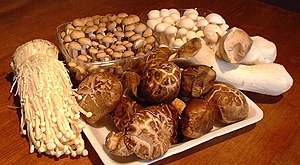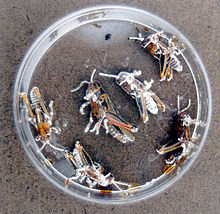| Fungi | |
|---|---|
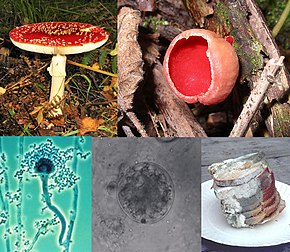
| |
Clockwise from top left:
| |
| Scientific classification | |
| (unranked): | Opisthokonta |
| (unranked): | Holomycota |
| (unranked): | Zoosporia |
| Kingdom: | Fungi |
| Subkingdoms/Phyla/Subphyla | |
|
Dikarya (inc. Deuteromycota)
Subphyla incertae sedis | |
A fungus is any member of the group of eukaryotic organisms that includes microorganisms such as yeasts and molds, as well as the more familiar mushrooms. These organisms are classified as a kingdom, fungi, which is separate from the other eukaryotic life kingdoms of plants and animals.
A characteristic that places fungi in a different kingdom from plants, bacteria, and some protists is chitin in their cell walls. Similar to animals, fungi are heterotrophs; they acquire their food by absorbing dissolved molecules, typically by secreting digestive enzymes into their environment. Fungi do not photosynthesise. Growth is their means of mobility, except for spores (a few of which are flagellated), which may travel through the air or water. Fungi are the principal decomposers in ecological systems. These and other differences place fungi in a single group of related organisms, named the Eumycota (true fungi or Eumycetes), which share a common ancestor (form a monophyletic group), an interpretation that is also strongly supported by molecular phylogenetics. This fungal group is distinct from the structurally similar myxomycetes (slime molds) and oomycetes (water molds). The discipline of biology devoted to the study of fungi is known as mycology (from the Greek μύκης mykes, mushroom). In the past, mycology was regarded as a branch of botany, although it is now known fungi are genetically more closely related to animals than to plants.
Abundant worldwide, most fungi are inconspicuous because of the small size of their structures, and their cryptic lifestyles in soil or on dead matter. Fungi include symbionts of plants, animals, or other fungi and also parasites. They may become noticeable when fruiting, either as mushrooms or as molds. Fungi perform an essential role in the decomposition of organic matter and have fundamental roles in nutrient cycling and exchange in the environment. They have long been used as a direct source of human food, in the form of mushrooms and truffles; as a leavening agent for bread; and in the fermentation of various food products, such as wine, beer, and soy sauce. Since the 1940s, fungi have been used for the production of antibiotics, and, more recently, various enzymes produced by fungi are used industrially and in detergents. Fungi are also used as biological pesticides to control weeds, plant diseases and insect pests. Many species produce bioactive compounds called mycotoxins, such as alkaloids and polyketides, that are toxic to animals including humans. The fruiting structures of a few species contain psychotropic compounds and are consumed recreationally or in traditional spiritual ceremonies. Fungi can break down manufactured materials and buildings, and become significant pathogens of humans and other animals. Losses of crops due to fungal diseases (e.g., rice blast disease) or food spoilage can have a large impact on human food supplies and local economies.
The fungus kingdom encompasses an enormous diversity of taxa with varied ecologies, life cycle strategies, and morphologies ranging from unicellular aquatic chytrids to large mushrooms. However, little is known of the true biodiversity of Kingdom Fungi, which has been estimated at 2.2 million to 3.8 million species. Of these, only about 120,000 have been described, with over 8,000 species known to be detrimental to plants and at least 300 that can be pathogenic to humans. Ever since the pioneering 18th and 19th century taxonomical works of Carl Linnaeus, Christian Hendrik Persoon, and Elias Magnus Fries, fungi have been classified according to their morphology (e.g., characteristics such as spore color or microscopic features) or physiology. Advances in molecular genetics have opened the way for DNA analysis to be incorporated into taxonomy, which has sometimes challenged the historical groupings based on morphology and other traits. Phylogenetic studies published in the last decade have helped reshape the classification within Kingdom Fungi, which is divided into one subkingdom, seven phyla, and ten subphyla.
Etymology
The English word fungus is directly adopted from the Latin fungus (mushroom), used in the writings of Horace and Pliny. This in turn is derived from the Greek word sphongos (σφόγγος "sponge"), which refers to the macroscopic structures and morphology of mushrooms and molds; the root is also used in other languages, such as the German Schwamm ("sponge") and Schimmel ("mold").The word mycology is derived from the Greek mykes (μύκης "mushroom") and logos (λόγος "discourse"). It denotes the scientific study of fungi. The Latin adjectival form of "mycology" (mycologicæ) appeared as early as 1796 in a book on the subject by Christiaan Hendrik Persoon. The word appeared in English as early as 1824 in a book by Robert Kaye Greville. In 1836 the English naturalist Miles Joseph Berkeley's publication The English Flora of Sir James Edward Smith, Vol. 5. also refers to mycology as the study of fungi.
A group of all the fungi present in a particular area or geographic region is known as mycobiota (plural noun, no singular), e.g., "the mycobiota of Ireland".
Characteristics
Fungal hyphae cells
- Hyphal wall
- Septum
- Mitochondrion
- Vacuole
- Ergosterol crystal
- Ribosome
- Nucleus
- Endoplasmic reticulum
- Lipid body
- Plasma membrane
- Spitzenkörper
- Golgi apparatus
Before the introduction of molecular methods for phylogenetic analysis, taxonomists considered fungi to be members of the plant kingdom because of similarities in lifestyle: both fungi and plants are mainly immobile, and have similarities in general morphology and growth habitat. Like plants, fungi often grow in soil and, in the case of mushrooms, form conspicuous fruit bodies, which sometimes resemble plants such as mosses. The fungi are now considered a separate kingdom, distinct from both plants and animals, from which they appear to have diverged around one billion years ago (around the start of the Neoproterozoic Era).
Some morphological, biochemical, and genetic features are shared with
other organisms, while others are unique to the fungi, clearly
separating them from the other kingdoms:
Shared features:
- With other eukaryotes: Fungal cells contain membrane-bound nuclei with chromosomes that contain DNA with noncoding regions called introns and coding regions called exons. Fungi have membrane-bound cytoplasmic organelles such as mitochondria, sterol-containing membranes, and ribosomes of the 80S type. They have a characteristic range of soluble carbohydrates and storage compounds, including sugar alcohols (e.g., mannitol), disaccharides, (e.g., trehalose), and polysaccharides (e.g., glycogen, which is also found in animals).
- With animals: Fungi lack chloroplasts and are heterotrophic organisms and so require preformed organic compounds as energy sources.
- With plants: Fungi have a cell wall and vacuoles. They reproduce by both sexual and asexual means, and like basal plant groups (such as ferns and mosses) produce spores. Similar to mosses and algae, fungi typically have haploid nuclei.
- With euglenoids and bacteria: Higher fungi, euglenoids, and some bacteria produce the amino acid L-lysine in specific biosynthesis steps, called the α-aminoadipate pathway.
- The cells of most fungi grow as tubular, elongated, and thread-like (filamentous) structures called hyphae, which may contain multiple nuclei and extend by growing at their tips. Each tip contains a set of aggregated vesicles—cellular structures consisting of proteins, lipids, and other organic molecules—called the Spitzenkörper. Both fungi and oomycetes grow as filamentous hyphal cells. In contrast, similar-looking organisms, such as filamentous green algae, grow by repeated cell division within a chain of cells. There are also single-celled fungi (yeasts) that do not form hyphae, and some fungi have both hyphal and yeast forms.
- In common with some plant and animal species, more than 70 fungal species display bioluminescence.
Unique features:
- Some species grow as unicellular yeasts that reproduce by budding or fission. Dimorphic fungi can switch between a yeast phase and a hyphal phase in response to environmental conditions.
- The fungal cell wall is composed of glucans and chitin; while glucans are also found in plants and chitin in the exoskeleton of arthropods, fungi are the only organisms that combine these two structural molecules in their cell wall. Unlike those of plants and oomycetes, fungal cell walls do not contain cellulose.
Omphalotus nidiformis, a bioluminescent mushroom
Most fungi lack an efficient system for the long-distance transport of water and nutrients, such as the xylem and phloem in many plants. To overcome this limitation, some fungi, such as Armillaria, form rhizomorphs, which resemble and perform functions similar to the roots of plants. As eukaryotes, fungi possess a biosynthetic pathway for producing terpenes that uses mevalonic acid and pyrophosphate as chemical building blocks.
Plants and some other organisms have an additional terpene biosynthesis
pathway in their chloroplasts, a structure fungi and animals do not
have. Fungi produce several secondary metabolites that are similar or identical in structure to those made by plants. Many of the plant and fungal enzymes that make these compounds differ from each other in sequence and other characteristics, which indicates separate origins and convergent evolution of these enzymes in the fungi and plants.
Diversity
Bracket fungi on a tree stump
Fungi have a worldwide distribution, and grow in a wide range of habitats, including extreme environments such as deserts or areas with high salt concentrations or ionizing radiation, as well as in deep sea sediments. Some can survive the intense UV and cosmic radiation encountered during space travel. Most grow in terrestrial environments, though several species live partly or solely in aquatic habitats, such as the chytrid fungus Batrachochytrium dendrobatidis, a parasite that has been responsible for a worldwide decline in amphibian populations. This organism spends part of its life cycle as a motile zoospore, enabling it to propel itself through water and enter its amphibian host. Other examples of aquatic fungi include those living in hydrothermal areas of the ocean.
Around 120,000 species of fungi have been described by taxonomists, but the global biodiversity of the fungus kingdom is not fully understood. A 2017 estimate suggests there may be between 2.2 and 3.8 million species. In mycology, species have historically been distinguished by a variety of methods and concepts. Classification based on morphological characteristics, such as the size and shape of spores or fruiting structures, has traditionally dominated fungal taxonomy. Species may also be distinguished by their biochemical and physiological characteristics, such as their ability to metabolize certain biochemicals, or their reaction to chemical tests. The biological species concept discriminates species based on their ability to mate. The application of molecular tools, such as DNA sequencing and phylogenetic analysis, to study diversity has greatly enhanced the resolution and added robustness to estimates of genetic diversity within various taxonomic groups.
Mycology
Mycology is the branch of biology
concerned with the systematic study of fungi, including their genetic
and biochemical properties, their taxonomy, and their use to humans as a
source of medicine, food, and psychotropic substances consumed for religious purposes, as well as their dangers, such as poisoning or infection. The field of phytopathology, the study of plant diseases, is closely related because many plant pathogens are fungi.
In 1729, Pier Antonio Micheli first published descriptions of fungi.
The use of fungi by humans dates back to prehistory; Ötzi the Iceman, a well-preserved mummy of a 5,300-year-old Neolithic man found frozen in the Austrian Alps, carried two species of polypore mushrooms that may have been used as tinder (Fomes fomentarius), or for medicinal purposes (Piptoporus betulinus).
Ancient peoples have used fungi as food sources–often unknowingly–for
millennia, in the preparation of leavened bread and fermented juices.
Some of the oldest written records contain references to the destruction
of crops that were probably caused by pathogenic fungi.
History
Mycology is a relatively new science that became systematic after the development of the microscope in the 17th century. Although fungal spores were first observed by Giambattista della Porta in 1588, the seminal work in the development of mycology is considered to be the publication of Pier Antonio Micheli's 1729 work Nova plantarum genera.
Micheli not only observed spores but also showed that, under the proper
conditions, they could be induced into growing into the same species of
fungi from which they originated. Extending the use of the binomial system of nomenclature introduced by Carl Linnaeus in his Species plantarum (1753), the Dutch Christian Hendrik Persoon
(1761–1836) established the first classification of mushrooms with such
skill as to be considered a founder of modern mycology. Later, Elias Magnus Fries (1794–1878) further elaborated the classification
of fungi, using spore color and microscopic characteristics, methods
still used by taxonomists today. Other notable early contributors to
mycology in the 17th–19th and early 20th centuries include Miles Joseph Berkeley, August Carl Joseph Corda, Anton de Bary, the brothers Louis René and Charles Tulasne, Arthur H. R. Buller, Curtis G. Lloyd, and Pier Andrea Saccardo. The 20th century has seen a modernization of mycology that has come from advances in biochemistry, genetics, molecular biology, and biotechnology. The use of DNA sequencing technologies and phylogenetic analysis has provided new insights into fungal relationships and biodiversity, and has challenged traditional morphology-based groupings in fungal taxonomy.
Morphology
Microscopic structures
An environmental isolate of Penicillium
Most fungi grow as hyphae, which are cylindrical, thread-like structures 2–10 µm
in diameter and up to several centimeters in length. Hyphae grow at
their tips (apices); new hyphae are typically formed by emergence of new
tips along existing hyphae by a process called branching, or occasionally growing hyphal tips fork, giving rise to two parallel-growing hyphae. Hyphae also sometimes fuse when they come into contact, a process called hyphal fusion (or anastomosis). These growth processes lead to the development of a mycelium, an interconnected network of hyphae. Hyphae can be either septate or coenocytic. Septate hyphae are divided into compartments separated by cross walls (internal cell walls, called septa, that are formed at right angles
to the cell wall giving the hypha its shape), with each compartment
containing one or more nuclei; coenocytic hyphae are not
compartmentalized. Septa have pores that allow cytoplasm, organelles, and sometimes nuclei to pass through; an example is the dolipore septum in fungi of the phylum Basidiomycota. Coenocytic hyphae are in essence multinucleate supercells.
Many species have developed specialized hyphal structures for nutrient uptake from living hosts; examples include haustoria in plant-parasitic species of most fungal phyla, and arbuscules of several mycorrhizal fungi, which penetrate into the host cells to consume nutrients.
Although fungi are opisthokonts—a grouping of evolutionarily related organisms broadly characterized by a single posterior flagellum—all phyla except for the chytrids have lost their posterior flagella. Fungi are unusual among the eukaryotes in having a cell wall that, in addition to glucans (e.g., β-1,3-glucan) and other typical components, also contains the biopolymer chitin.
Macroscopic structures
Fungal mycelia can become visible to the naked eye, for example, on various surfaces and substrates, such as damp walls and spoiled food, where they are commonly called molds. Mycelia grown on solid agar media in laboratory petri dishes are usually referred to as colonies. These colonies can exhibit growth shapes and colors (due to spores or pigmentation) that can be used as diagnostic features in the identification of species or groups. Some individual fungal colonies can reach extraordinary dimensions and ages as in the case of a clonal colony of Armillaria solidipes, which extends over an area of more than 900 ha (3.5 square miles), with an estimated age of nearly 9,000 years.
The apothecium—a specialized structure important in sexual reproduction in the ascomycetes—is a cup-shaped fruit body that is often macroscopic and holds the hymenium, a layer of tissue containing the spore-bearing cells. The fruit bodies of the basidiomycetes (basidiocarps) and some ascomycetes can sometimes grow very large, and many are well known as mushrooms.
Growth and physiology
The growth of fungi as hyphae on or in solid substrates or as single
cells in aquatic environments is adapted for the efficient extraction of
nutrients, because these growth forms have high surface area to volume ratios. Hyphae are specifically adapted for growth on solid surfaces, and to invade substrates and tissues. They can exert large penetrative mechanical forces; for example, many plant pathogens, including Magnaporthe grisea, form a structure called an appressorium that evolved to puncture plant tissues. The pressure generated by the appressorium, directed against the plant epidermis, can exceed 8 megapascals (1,200 psi). The filamentous fungus Paecilomyces lilacinus uses a similar structure to penetrate the eggs of nematodes.
The mechanical pressure exerted by the appressorium is generated from physiological processes that increase intracellular turgor by producing osmolytes such as glycerol. Adaptations such as these are complemented by hydrolytic enzymes secreted into the environment to digest large organic molecules—such as polysaccharides, proteins, and lipids—into smaller molecules that may then be absorbed as nutrients.
The vast majority of filamentous fungi grow in a polar fashion
(extending in one direction) by elongation at the tip (apex) of the
hypha.
Other forms of fungal growth include intercalary extension
(longitudinal expansion of hyphal compartments that are below the apex)
as in the case of some endophytic fungi, or growth by volume expansion during the development of mushroom stipes and other large organs. Growth of fungi as multicellular structures consisting of somatic and reproductive cells—a feature independently evolved in animals and plants—has several functions, including the development of fruit bodies for dissemination of sexual spores (see above) and biofilms for substrate colonization and intercellular communication.
The fungi are traditionally considered heterotrophs, organisms that rely solely on carbon fixed by other organisms for metabolism. Fungi have evolved
a high degree of metabolic versatility that allows them to use a
diverse range of organic substrates for growth, including simple
compounds such as nitrate, ammonia, acetate, or ethanol. In some species the pigment melanin may play a role in extracting energy from ionizing radiation, such as gamma radiation. This form of "radiotrophic" growth has been described for only a few species, the effects on growth rates are small, and the underlying biophysical and biochemical processes are not well known. This process might bear similarity to CO2 fixation via visible light, but instead uses ionizing radiation as a source of energy.
Reproduction
Fungal reproduction is complex, reflecting the differences in
lifestyles and genetic makeup within this diverse kingdom of organisms.
It is estimated that a third of all fungi reproduce using more than one
method of propagation; for example, reproduction may occur in two
well-differentiated stages within the life cycle of a species, the teleomorph and the anamorph.
Environmental conditions trigger genetically determined developmental
states that lead to the creation of specialized structures for sexual or
asexual reproduction. These structures aid reproduction by efficiently
dispersing spores or spore-containing propagules.
Asexual reproduction
Asexual reproduction occurs via vegetative spores (conidia) or through mycelial fragmentation.
Mycelial fragmentation occurs when a fungal mycelium separates into
pieces, and each component grows into a separate mycelium. Mycelial
fragmentation and vegetative spores maintain clonal populations adapted to a specific niche, and allow more rapid dispersal than sexual reproduction. The "Fungi imperfecti" (fungi lacking the perfect or sexual stage) or Deuteromycota comprise all the species that lack an observable sexual cycle. Deuteromycota is not an accepted taxonomic clade, and is now taken to mean simply fungi that lack a known sexual stage.
Sexual reproduction
Sexual reproduction with meiosis has been directly observed in all fungal phyla except Glomeromycota
(genetic analysis suggests meiosis in Glomeromycota as well). It
differs in many aspects from sexual reproduction in animals or plants.
Differences also exist between fungal groups and can be used to
discriminate species by morphological differences in sexual structures
and reproductive strategies. Mating experiments between fungal isolates may identify species on the basis of biological species concepts.
The major fungal groupings have initially been delineated based on the
morphology of their sexual structures and spores; for example, the
spore-containing structures, asci and basidia, can be used in the identification of ascomycetes and basidiomycetes, respectively. Fungi employ two mating systems: heterothallic species allow mating only between individuals of opposite mating type, whereas homothallic species can mate, and sexually reproduce, with any other individual or itself.
Most fungi have both a haploid and a diploid
stage in their life cycles. In sexually reproducing fungi, compatible
individuals may combine by fusing their hyphae together into an
interconnected network; this process, anastomosis, is required for the initiation of the sexual cycle. Many ascomycetes and basidiomycetes go through a dikaryotic
stage, in which the nuclei inherited from the two parents do not
combine immediately after cell fusion, but remain separate in the hyphal
cells (see heterokaryosis).
The 8-spore asci of Morchella elata, viewed with phase contrast microscopy
In ascomycetes, dikaryotic hyphae of the hymenium (the spore-bearing tissue layer) form a characteristic hook at the hyphal septum. During cell division,
formation of the hook ensures proper distribution of the newly divided
nuclei into the apical and basal hyphal compartments. An ascus (plural asci) is then formed, in which karyogamy (nuclear fusion) occurs. Asci are embedded in an ascocarp, or fruiting body. Karyogamy in the asci is followed immediately by meiosis and the production of ascospores. After dispersal, the ascospores may germinate and form a new haploid mycelium.
Sexual reproduction in basidiomycetes is similar to that of the
ascomycetes. Compatible haploid hyphae fuse to produce a dikaryotic
mycelium. However, the dikaryotic phase is more extensive in the
basidiomycetes, often also present in the vegetatively growing mycelium.
A specialized anatomical structure, called a clamp connection,
is formed at each hyphal septum. As with the structurally similar hook
in the ascomycetes, the clamp connection in the basidiomycetes is
required for controlled transfer of nuclei during cell division, to
maintain the dikaryotic stage with two genetically different nuclei in
each hyphal compartment. A basidiocarp is formed in which club-like structures known as basidia generate haploid basidiospores after karyogamy and meiosis. The most commonly known basidiocarps are mushrooms, but they may also take other forms.
In fungi formerly classified as Zygomycota, haploid hyphae of two individuals fuse, forming a gametangium, a specialized cell structure that becomes a fertile gamete-producing cell. The gametangium develops into a zygospore, a thick-walled spore formed by the union of gametes. When the zygospore germinates, it undergoes meiosis, generating new haploid hyphae, which may then form asexual sporangiospores.
These sporangiospores allow the fungus to rapidly disperse and
germinate into new genetically identical haploid fungal mycelia.
Spore dispersal
Both asexual and sexual spores or sporangiospores are often actively
dispersed by forcible ejection from their reproductive structures. This
ejection ensures exit of the spores from the reproductive structures as
well as traveling through the air over long distances.
The bird's nest fungus Cyathus stercoreus
Specialized mechanical and physiological mechanisms, as well as spore surface structures (such as hydrophobins), enable efficient spore ejection. For example, the structure of the spore-bearing cells in some ascomycete species is such that the buildup of substances affecting cell volume and fluid balance enables the explosive discharge of spores into the air. The forcible discharge of single spores termed ballistospores
involves formation of a small drop of water (Buller's drop), which upon
contact with the spore leads to its projectile release with an initial
acceleration of more than 10,000 g;
the net result is that the spore is ejected 0.01–0.02 cm, sufficient
distance for it to fall through the gills or pores into the air below. Other fungi, like the puffballs, rely on alternative mechanisms for spore release, such as external mechanical forces. The bird's nest fungi use the force of falling water drops to liberate the spores from cup-shaped fruiting bodies. Another strategy is seen in the stinkhorns, a group of fungi with lively colors and putrid odor that attract insects to disperse their spores.
The most common means of spore dispersal is by wind - species
using this form of dispersal often produce dry or hydrophobic spores
which do not absorb water and are readily scattered by raindrops, for
example. Most of the researched species of fungus are transported by
wind.
Other sexual processes
Besides regular sexual reproduction with meiosis, certain fungi, such as those in the genera Penicillium and Aspergillus, may exchange genetic material via parasexual processes, initiated by anastomosis between hyphae and plasmogamy of fungal cells.
The frequency and relative importance of parasexual events is unclear
and may be lower than other sexual processes. It is known to play a role
in intraspecific hybridization and is likely required for hybridization between species, which has been associated with major events in fungal evolution.
Evolution
In contrast to plants and animals,
the early fossil record of the fungi is meager. Factors that likely
contribute to the under-representation of fungal species among fossils
include the nature of fungal fruiting bodies,
which are soft, fleshy, and easily degradable tissues and the
microscopic dimensions of most fungal structures, which therefore are
not readily evident. Fungal fossils are difficult to distinguish from
those of other microbes, and are most easily identified when they
resemble extant fungi. Often recovered from a permineralized plant or animal host, these samples are typically studied by making thin-section preparations that can be examined with light microscopy or transmission electron microscopy. Researchers study compression fossils by dissolving the surrounding matrix with acid and then using light or scanning electron microscopy to examine surface details.
The earliest fossils possessing features typical of fungi date to the Paleoproterozoic era, some 2,400 million years ago (Ma); these multicellular benthic organisms had filamentous structures capable of anastomosis.
Other studies (2009) estimate the arrival of fungal organisms at about
760–1060 Ma on the basis of comparisons of the rate of evolution in
closely related groups. For much of the Paleozoic Era (542–251 Ma), the fungi appear to have been aquatic and consisted of organisms similar to the extant chytrids in having flagellum-bearing spores.
The evolutionary adaptation from an aquatic to a terrestrial lifestyle
necessitated a diversification of ecological strategies for obtaining
nutrients, including parasitism, saprobism, and the development of mutualistic relationships such as mycorrhiza and lichenization. Recent (2009) studies suggest that the ancestral ecological state of the Ascomycota was saprobism, and that independent lichenization events have occurred multiple times.
It is presumed that the fungi colonized the land during the Cambrian (542–488.3 Ma), long before land plants. Fossilized hyphae and spores recovered from the Ordovician of Wisconsin (460 Ma) resemble modern-day Glomerales, and existed at a time when the land flora likely consisted of only non-vascular bryophyte-like plants. Prototaxites, which was probably a fungus or lichen, would have been the tallest organism of the late Silurian. Fungal fossils do not become common and uncontroversial until the early Devonian (416–359.2 Ma), when they occur abundantly in the Rhynie chert, mostly as Zygomycota and Chytridiomycota. At about this same time, approximately 400 Ma, the Ascomycota and Basidiomycota diverged, and all modern classes of fungi were present by the Late Carboniferous (Pennsylvanian, 318.1–299 Ma).
Lichen-like fossils have been found in the Doushantuo Formation in southern China dating back to 635–551 Ma.
Lichens formed a component of the early terrestrial ecosystems, and the
estimated age of the oldest terrestrial lichen fossil is 400 Ma; this date corresponds to the age of the oldest known sporocarp fossil, a Paleopyrenomycites species found in the Rhynie Chert. The oldest fossil with microscopic features resembling modern-day basidiomycetes is Palaeoancistrus, found permineralized with a fern from the Pennsylvanian. Rare in the fossil record are the Homobasidiomycetes (a taxon roughly equivalent to the mushroom-producing species of the Agaricomycetes). Two amber-preserved specimens provide evidence that the earliest known mushroom-forming fungi (the extinct species Archaeomarasmius leggetti) appeared during the late Cretaceous, 90 Ma.
Some time after the Permian–Triassic extinction event (251.4 Ma), a fungal spike (originally thought to be an extraordinary abundance of fungal spores in sediments) formed, suggesting that fungi were the dominant life form at this time, representing nearly 100% of the available fossil record for this period. However, the relative proportion of fungal spores relative to spores formed by algal species is difficult to assess, the spike did not appear worldwide, and in many places it did not fall on the Permian–Triassic boundary.
65 million years ago, immediately after the Cretaceous–Paleogene extinction event
that famously killed off most dinosaurs, there is a dramatic increase
in evidence of fungi, apparently the death of most plant and animal
species leading to a huge fungal bloom like "a massive compost heap".
Taxonomy
Although commonly included in botany curricula and textbooks, fungi are more closely related to animals than to plants and are placed with the animals in the monophyletic group of opisthokonts. Analyses using molecular phylogenetics support a monophyletic origin of fungi. The taxonomy
of fungi is in a state of constant flux, especially due to recent
research based on DNA comparisons. These current phylogenetic analyses
often overturn classifications based on older and sometimes less
discriminative methods based on morphological features and biological
species concepts obtained from experimental matings.
There is no unique generally accepted system at the higher
taxonomic levels and there are frequent name changes at every level,
from species upwards. Efforts among researchers are now underway to
establish and encourage usage of a unified and more consistent nomenclature.
Fungal species can also have multiple scientific names depending on
their life cycle and mode (sexual or asexual) of reproduction. Web sites
such as Index Fungorum and ITIS list current names of fungal species (with cross-references to older synonyms).
The 2007 classification of Kingdom Fungi is the result of a
large-scale collaborative research effort involving dozens of
mycologists and other scientists working on fungal taxonomy. It recognizes seven phyla, two of which—the Ascomycota and the Basidiomycota—are contained within a branch representing subkingdom
Dikarya, the most species rich and familiar group, including all the
mushrooms, most food-spoilage molds, most plant pathogenic fungi, and
the beer, wine, and bread yeasts.
Taxonomic groups
Main groups of fungi.
The major phyla (sometimes called divisions) of fungi have been classified mainly on the basis of characteristics of their sexual reproductive
structures. Currently, seven phyla are proposed: Microsporidia,
Chytridiomycota, Blastocladiomycota, Neocallimastigomycota,
Glomeromycota, Ascomycota, and Basidiomycota.
Phylogenetic analysis has demonstrated that the Microsporidia, unicellular parasites of animals and protists, are fairly recent and highly derived endobiotic fungi (living within the tissue of another species).
One 2006 study concludes that the Microsporidia are a sister group to
the true fungi; that is, they are each other's closest evolutionary
relative.
Hibbett and colleagues suggest that this analysis does not clash with
their classification of the Fungi, and although the Microsporidia are
elevated to phylum status, it is acknowledged that further analysis is
required to clarify evolutionary relationships within this group.
The Chytridiomycota are commonly known as chytrids. These fungi are distributed worldwide. Chytrids and their close relatives Neocallimastigomycota and Blastocladiomycota (below) are the only fungi with active motility, producing zoospores that are capable of active movement through aqueous phases with a single flagellum, leading early taxonomists to classify them as protists. Molecular phylogenies, inferred from rRNA sequences in ribosomes, suggest that the Chytrids are a basal group divergent from the other fungal phyla, consisting of four major clades with suggestive evidence for paraphyly or possibly polyphyly.
The Blastocladiomycota were previously considered a taxonomic clade within the Chytridiomycota. Recent molecular data and ultrastructural
characteristics, however, place the Blastocladiomycota as a sister
clade to the Zygomycota, Glomeromycota, and Dikarya (Ascomycota and
Basidiomycota). The blastocladiomycetes are saprotrophs,
feeding on decomposing organic matter, and they are parasites of all
eukaryotic groups. Unlike their close relatives, the chytrids, most of
which exhibit zygotic meiosis, the blastocladiomycetes undergo sporic meiosis.
The Neocallimastigomycota were earlier placed in the phylum Chytridomycota. Members of this small phylum are anaerobic organisms,
living in the digestive system of larger herbivorous mammals and in
other terrestrial and aquatic environments enriched in cellulose (e.g.,
domestic waste landfill sites). They lack mitochondria but contain hydrogenosomes
of mitochondrial origin. As in the related chrytrids,
neocallimastigomycetes form zoospores that are posteriorly uniflagellate
or polyflagellate.
Arbuscular mycorrhiza seen under microscope. Flax root cortical cells containing paired arbuscules.
Diagram of an apothecium (the typical cup-like reproductive structure of Ascomycetes) showing sterile tissues as well as developing and mature asci.
Members of the Glomeromycota form arbuscular mycorrhizae, a form of mutualist symbiosis
wherein fungal hyphae invade plant root cells and both species benefit
from the resulting increased supply of nutrients. All known
Glomeromycota species reproduce asexually. The symbiotic association between the Glomeromycota and plants is ancient, with evidence dating to 400 million years ago. Formerly part of the Zygomycota
(commonly known as 'sugar' and 'pin' molds), the Glomeromycota were
elevated to phylum status in 2001 and now replace the older phylum
Zygomycota. Fungi that were placed in the Zygomycota are now being reassigned to the Glomeromycota, or the subphyla incertae sedis Mucoromycotina, Kickxellomycotina, the Zoopagomycotina and the Entomophthoromycotina. Some well-known examples of fungi formerly in the Zygomycota include black bread mold (Rhizopus stolonifer), and Pilobolus species, capable of ejecting spores several meters through the air. Medically relevant genera include Mucor, Rhizomucor, and Rhizopus.
The Ascomycota, commonly known as sac fungi or ascomycetes, constitute the largest taxonomic group within the Eumycota. These fungi form meiotic spores called ascospores, which are enclosed in a special sac-like structure called an ascus. This phylum includes morels, a few mushrooms and truffles, unicellular yeasts (e.g., of the genera Saccharomyces, Kluyveromyces, Pichia, and Candida),
and many filamentous fungi living as saprotrophs, parasites, and
mutualistic symbionts (e.g. lichens). Prominent and important genera of
filamentous ascomycetes include Aspergillus, Penicillium, Fusarium, and Claviceps. Many ascomycete species have only been observed undergoing asexual reproduction (called anamorphic species), but analysis of molecular data has often been able to identify their closest teleomorphs in the Ascomycota.
Because the products of meiosis are retained within the sac-like ascus,
ascomycetes have been used for elucidating principles of genetics and
heredity (e.g., Neurospora crassa).
Members of the Basidiomycota, commonly known as the club fungi or basidiomycetes, produce meiospores called basidiospores on club-like stalks called basidia. Most common mushrooms belong to this group, as well as rust and smut fungi, which are major pathogens of grains. Other important basidiomycetes include the maize pathogen Ustilago maydis, human commensal species of the genus Malassezia, and the opportunistic human pathogen, Cryptococcus neoformans.
Fungus-like organisms
Because of similarities in morphology and lifestyle, the slime molds (mycetozoans, plasmodiophorids, acrasids, Fonticula and labyrinthulids, now in Amoebozoa, Rhizaria, Excavata, Opisthokonta and Stramenopiles, respectively), water molds (oomycetes) and hyphochytrids (both Stramenopiles) were formerly classified in the kingdom Fungi, in groups like Mastigomycotina, Gymnomycota and Phycomycetes. The slime molds were studied also as protozoans, leading to a ambiregnal, duplicated taxonomy.
Unlike true fungi, the cell walls of oomycetes contain cellulose and lack chitin.
Hyphochytrids have both chitin and cellulose. Slime molds lack a cell
wall during the assimilative phase (except labyrinthulids, which have a
wall of scales), and ingest nutrients by ingestion (phagocytosis, except labyrinthulids) rather than absorption (osmotrophy,
as fungi, labyrinthulids, oomycetes and hyphochytrids). Neither water
molds nor slime molds are closely related to the true fungi, and,
therefore, taxonomists no longer group them in the kingdom Fungi. Nonetheless, studies of the oomycetes and myxomycetes are still often included in mycology textbooks and primary research literature.
The Eccrinales and Amoebidiales are opisthokont protists, previously thought to be zygomycete fungi. Other groups now in Opisthokonta (e.g., Corallochytrium, Ichthyosporea) were also at given time classified as fungi. The genus Blastocystis, now in Stramenopiles, was originally classified as a yeast. Ellobiopsis, now in Alveolata, was considered a chytrid. The bacteria were also included in fungi in some classifications, as the group Schizomycetes.
The Rozellida clade, including the "ex-chytrid" Rozella,
is a genetically disparate group known mostly from environmental DNA
sequences that is a sister group to fungi. Members of the group that
have been isolated lack the chitinous cell wall that is characteristic
of fungi.
The nucleariids may be the next sister group to the eumycete clade, and as such could be included in an expanded fungal kingdom.
Many Actinomycetales (Actinobacteria), a group with many filamentous bacteria, were also long believed to be fungi.
Ecology
A pin mold decomposing a peach
Although often inconspicuous, fungi occur in every environment on Earth and play very important roles in most ecosystems. Along with bacteria, fungi are the major decomposers in most terrestrial (and some aquatic) ecosystems, and therefore play a critical role in biogeochemical cycles and in many food webs. As decomposers, they play an essential role in nutrient cycling, especially as saprotrophs and symbionts, degrading organic matter to inorganic molecules, which can then re-enter anabolic metabolic pathways in plants or other organisms.
Symbiosis
Many fungi have important symbiotic relationships with organisms from most if not all Kingdoms. These interactions can be mutualistic or antagonistic in nature, or in the case of commensal fungi are of no apparent benefit or detriment to the host.
With plants
Mycorrhizal symbiosis between plants
and fungi is one of the most well-known plant–fungus associations and
is of significant importance for plant growth and persistence in many
ecosystems; over 90% of all plant species engage in mycorrhizal
relationships with fungi and are dependent upon this relationship for
survival.
The dark filaments are hyphae of the endophytic fungus Neotyphodium coenophialum in the intercellular spaces of tall fescue leaf sheath tissue
The mycorrhizal symbiosis is ancient, dating to at least 400 million years ago. It often increases the plant's uptake of inorganic compounds, such as nitrate and phosphate from soils having low concentrations of these key plant nutrients. The fungal partners may also mediate plant-to-plant transfer of carbohydrates and other nutrients. Such mycorrhizal communities are called "common mycorrhizal networks". A special case of mycorrhiza is myco-heterotrophy, whereby the plant parasitizes the fungus, obtaining all of its nutrients from its fungal symbiont. Some fungal species inhabit the tissues inside roots, stems, and leaves, in which case they are called endophytes.
Similar to mycorrhiza, endophytic colonization by fungi may benefit
both symbionts; for example, endophytes of grasses impart to their host
increased resistance to herbivores and other environmental stresses and
receive food and shelter from the plant in return.
With algae and cyanobacteria
The lichen Lobaria pulmonaria, a symbiosis of fungal, algal, and cyanobacterial species
Lichens are a symbiotic relationship between fungi and photosynthetic algae or cyanobacteria.
The photosynthetic partner in the relationship is referred to in lichen
terminology as a "photobiont". The fungal part of the relationship is
composed mostly of various species of ascomycetes and a few basidiomycetes. Lichens occur in every ecosystem on all continents, play a key role in soil formation and the initiation of biological succession, and are prominent in some extreme environments, including polar, alpine, and semiarid desert regions. They are able to grow on inhospitable surfaces, including bare soil, rocks, tree bark, wood, shells, barnacles and leaves. As in mycorrhizas, the photobiont provides sugars and other carbohydrates via photosynthesis
to the fungus, while the fungus provides minerals and water to the
photobiont. The functions of both symbiotic organisms are so closely
intertwined that they function almost as a single organism; in most
cases the resulting organism differs greatly from the individual
components. Lichenization is a common mode of nutrition for fungi;
around 20% of fungi—between 17,500 and 20,000 described species—are
lichenized. Characteristics common to most lichens include obtaining organic carbon by photosynthesis, slow growth, small size, long life, long-lasting (seasonal) vegetative reproductive structures, mineral nutrition obtained largely from airborne sources, and greater tolerance of desiccation than most other photosynthetic organisms in the same habitat.
With insects
Many insects also engage in mutualistic relationships with fungi. Several groups of ants cultivate fungi in the order Agaricales as their primary food source, while ambrosia beetles cultivate various species of fungi in the bark of trees that they infest. Likewise, females of several wood wasp species (genus Sirex) inject their eggs together with spores of the wood-rotting fungus Amylostereum areolatum into the sapwood of pine trees; the growth of the fungus provides ideal nutritional conditions for the development of the wasp larvae. At least one species of stingless bee has a relationship with a fungus in the genus Monascus, where the larvae consume and depend on fungus transferred from old to new nests. Termites on the African savannah are also known to cultivate fungi, and yeasts of the genera Candida and Lachancea inhabit the gut of a wide range of insects, including neuropterans, beetles, and cockroaches; it is not known whether these fungi benefit their hosts. Fungi ingrowing dead wood are essential for xylophagous insects (e.g. woodboring beetles). They deliver nutrients needed by xylophages to nutritionally scarce dead wood. Thanks to this nutritional enrichment the larvae of woodboring insect is able to grow and develop to adulthood. The larvae of many families of fungicolous flies, particularly those within the superfamily Sciaroidea such as the Mycetophilidae and some Keroplatidae feed on fungal fruiting bodies and sterile mycorrhizae.
As pathogens and parasites
The plant pathogen Aecidium magellanicum causes calafate rust, seen here on a Berberis shrub in Chile.
Many fungi are parasites
on plants, animals (including humans), and other fungi. Serious
pathogens of many cultivated plants causing extensive damage and losses
to agriculture and forestry include the rice blast fungus Magnaporthe oryzae, tree pathogens such as Ophiostoma ulmi and Ophiostoma novo-ulmi causing Dutch elm disease and Cryphonectria parasitica responsible for chestnut blight, and plant pathogens in the genera Fusarium, Ustilago, Alternaria, and Cochliobolus. Some carnivorous fungi, like Paecilomyces lilacinus, are predators of nematodes, which they capture using an array of specialized structures such as constricting rings or adhesive nets. Many fungi that are plant pathogens, such as Magnaporthe oryzae,
can switch from being biotrophic (parasitic on living plants) to being
necrotrophic (feeding on the dead tissues of plants they have killed).
Some fungi can cause serious diseases in humans, several of which may be fatal if untreated. These include aspergillosis, candidiasis, coccidioidomycosis, cryptococcosis, histoplasmosis, mycetomas, and paracoccidioidomycosis. Furthermore, persons with immuno-deficiencies are particularly susceptible to disease by genera such as Aspergillus, Candida, Cryptoccocus, Histoplasma, and Pneumocystis. Other fungi can attack eyes, nails, hair, and especially skin, the so-called dermatophytic and keratinophilic fungi, and cause local infections such as ringworm and athlete's foot. Fungal spores are also a cause of allergies, and fungi from different taxonomic groups can evoke allergic reactions.
As targets of mycoparasites
The organisms which parasitize fungi are known as mycoparasitic organisms. Certain species of the genus Pythium, which are oomycetes, have potential as biocontrol agents against certain fungi. Fungi can also act as mycoparasites or antagonists of other fungi, such as Hypomyces chrysospermus, which grows on bolete mushrooms.
Fungi can become the target of infection by mycoviruses.
Mycotoxins
Ergotamine, a major mycotoxin produced by Claviceps species, which if ingested can cause gangrene, convulsions, and hallucinations
Many fungi produce biologically active compounds, several of which are toxic to animals or plants and are therefore called mycotoxins.
Of particular relevance to humans are mycotoxins produced by molds
causing food spoilage, and poisonous mushrooms (see above). Particularly
infamous are the lethal amatoxins in some Amanita mushrooms, and ergot alkaloids, which have a long history of causing serious epidemics of ergotism (St Anthony's Fire) in people consuming rye or related cereals contaminated with sclerotia of the ergot fungus, Claviceps purpurea. Other notable mycotoxins include the aflatoxins, which are insidious liver toxins and highly carcinogenic metabolites produced by certain Aspergillus species often growing in or on grains and nuts consumed by humans, ochratoxins, patulin, and trichothecenes (e.g., T-2 mycotoxin) and fumonisins, which have significant impact on human food supplies or animal livestock.
Mycotoxins are secondary metabolites (or natural products),
and research has established the existence of biochemical pathways
solely for the purpose of producing mycotoxins and other natural
products in fungi. Mycotoxins may provide fitness benefits in terms of physiological adaptation, competition with other microbes and fungi, and protection from consumption (fungivory). Many fungal secondary metabolites (or derivatives) are used medically, as described under Human Use below.
Pathogenic mechanisms
Ustilago maydis is a pathogenic plant fungus that causes smut disease in maize and teosinte. Plants have evolved efficient defense systems against pathogenic microbes such as U. maydis. A rapid defense reaction after pathogen attack is the oxidative burst where the plant produces reactive oxygen species at the site of the attempted invasion. U. maydis can respond to the oxidative burst with an oxidative stress response, regulated by the gene YAP1. The response protects U. maydis from the host defense, and is necessary for the pathogen's virulence. Furthermore, U. maydis has a well-established recombinational DNA repair system which acts during mitosis and meiosis.
The system may assist the pathogen in surviving DNA damage arising from
the host plant's oxidative defensive response to infection.
Cryptococcus neoformans is an encapsulated yeast that can live in both plants and animals. C. neoformans usually infects the lungs, where it is phagocytosed by alveolar macrophages. Some C. neoformans can survive inside macrophages, which appears to be the basis for latency, disseminated disease, and resistance to antifungal agents. One mechanism by which C. neoformans
survives the hostile macrophage environment is by up-regulating the
expression of genes involved in the oxidative stress response. Another mechanism involves meiosis. The majority of C. neoformans
are mating "type a". Filaments of mating "type a" ordinarily have
haploid nuclei, but they can become diploid (perhaps by endoduplication
or by stimulated nuclear fusion) to form blastospores.
The diploid nuclei of blastospores can undergo meiosis, including
recombination, to form haploid basidiospores that can be dispersed. This process is referred to as monokaryotic fruiting. this process requires a gene called DMC1, which is a conserved homologue of genes recA in bacteria and RAD51 in eukaryotes, that mediates homologous chromosome pairing during meiosis and repair of DNA double-strand breaks. Thus, C. neoformans
can undergo a meiosis, monokaryotic fruiting, that promotes
recombinational repair in the oxidative, DNA damaging environment of the
host macrophage, and the repair capability may contribute to its
virulence.
Human use
Saccharomyces cerevisiae cells shown with DIC microscopy
The human use of fungi for food preparation or preservation and other purposes is extensive and has a long history. Mushroom farming and mushroom gathering are large industries in many countries. The study of the historical uses and sociological impact of fungi is known as ethnomycology. Because of the capacity of this group to produce an enormous range of natural products with antimicrobial or other biological activities, many species have long been used or are being developed for industrial production of antibiotics, vitamins, and anti-cancer and cholesterol-lowering drugs. More recently, methods have been developed for genetic engineering of fungi, enabling metabolic engineering of fungal species. For example, genetic modification of yeast species—which are easy to grow at fast rates in large fermentation vessels—has opened up ways of pharmaceutical production that are potentially more efficient than production by the original source organisms.
Therapeutic uses
Modern chemotherapeutics
The mould Penicillium chrysogenum was the source of penicillin G.
Many species produce metabolites that are major sources of pharmacologically active drugs. Particularly important are the antibiotics, including the penicillins, a structurally related group of β-lactam antibiotics that are synthesized from small peptides. Although naturally occurring penicillins such as penicillin G (produced by Penicillium chrysogenum) have a relatively narrow spectrum of biological activity, a wide range of other penicillins can be produced by chemical modification of the natural penicillins. Modern penicillins are semisynthetic compounds, obtained initially from fermentation cultures, but then structurally altered for specific desirable properties. Other antibiotics produced by fungi include: ciclosporin, commonly used as an immunosuppressant during transplant surgery; and fusidic acid, used to help control infection from methicillin-resistant Staphylococcus aureus bacteria. Widespread use of antibiotics for the treatment of bacterial diseases, such as tuberculosis, syphilis, leprosy,
and others began in the early 20th century and continues to date. In
nature, antibiotics of fungal or bacterial origin appear to play a dual
role: at high concentrations they act as chemical defense against
competition with other microorganisms in species-rich environments, such
as the rhizosphere, and at low concentrations as quorum-sensing molecules for intra- or interspecies signaling. Other drugs produced by fungi include griseofulvin isolated from Penicillium griseofulvum, used to treat fungal infections, and statins (HMG-CoA reductase inhibitors), used to inhibit cholesterol synthesis. Examples of statins found in fungi include mevastatin from Penicillium citrinum and lovastatin from Aspergillus terreus and the oyster mushroom. Fungi produce compounds that inhibit viruses and cancer cells. Specific metabolites, such as polysaccharide-K, ergotamine, and β-lactam antibiotics, are routinely used in clinical medicine. The shiitake mushroom is a source of lentinan, a clinical drug approved for use in cancer treatments in several countries, including Japan. In Europe and Japan, polysaccharide-K (brand name Krestin), a chemical derived from Trametes versicolor, is an approved adjuvant for cancer therapy.
Traditional and folk medicine
The medicinal fungi Ganoderma lucidum (top) and Ophiocordyceps sinensis (bottom)
Certain mushrooms enjoy usage as therapeutics in folk medicines, such as Traditional Chinese medicine. Notable medicinal mushrooms with a well-documented history of use include Agaricus subrufescens, Ganoderma lucidum,, Psilocybe and Ophiocordyceps sinensis.
Cultured foods
Baker's yeast or Saccharomyces cerevisiae, a unicellular fungus, is used to make bread and other wheat-based products, such as pizza dough and dumplings. Yeast species of the genus Saccharomyces are also used to produce alcoholic beverages through fermentation. Shoyu koji mold (Aspergillus oryzae) is an essential ingredient in brewing Shoyu (soy sauce) and sake, and the preparation of miso, while Rhizopus species are used for making tempeh. Several of these fungi are domesticated species that were bred
or selected according to their capacity to ferment food without
producing harmful mycotoxins, which are produced by very
closely related Aspergilli. Quorn, a meat substitute, is made from Fusarium venenatum.
In food
A selection of edible mushrooms eaten in Asia
Edible mushrooms include commercially raised and wild-harvested fungi. Agaricus bisporus,
sold as button mushrooms when small or Portobello mushrooms when
larger, is the most widely cultivated species in the West, used in
salads, soups, and many other dishes. Many Asian fungi are commercially
grown and have increased in popularity in the West. They are often
available fresh in grocery stores and markets, including straw mushrooms (Volvariella volvacea), oyster mushrooms (Pleurotus ostreatus), shiitakes (Lentinula edodes), and enokitake (Flammulina spp.).
Stilton cheese veined with Penicillium roqueforti
Many other mushroom species are harvested from the wild for personal consumption or commercial sale. Milk mushrooms, morels, chanterelles, truffles, black trumpets, and porcini mushrooms (Boletus edulis) (also known as king boletes) demand a high price on the market. They are often used in gourmet dishes.
Certain types of cheeses require inoculation of milk curds with
fungal species that impart a unique flavor and texture to the cheese.
Examples include the blue color in cheeses such as Stilton or Roquefort, which are made by inoculation with Penicillium roqueforti. Molds used in cheese production are non-toxic and are thus safe for human consumption; however, mycotoxins (e.g., aflatoxins, roquefortine C, patulin, or others) may accumulate because of growth of other fungi during cheese ripening or storage.
Poisonous fungi
Amanita phalloides accounts for the majority of fatal mushroom poisonings worldwide. It sometimes lacks the greenish color seen here.
Many mushroom species are poisonous to humans, with toxicities ranging from slight digestive problems or allergic reactions as well as hallucinations to severe organ failures and death. Genera with mushrooms containing deadly toxins include Conocybe, Galerina, Lepiota, and, the most infamous, Amanita. The latter genus includes the destroying angel (A. virosa) and the death cap (A. phalloides), the most common cause of deadly mushroom poisoning. The false morel (Gyromitra esculenta) is occasionally considered a delicacy when cooked, yet can be highly toxic when eaten raw. Tricholoma equestre was considered edible until it was implicated in serious poisonings causing rhabdomyolysis. Fly agaric mushrooms (Amanita muscaria) also cause occasional non-fatal poisonings, mostly as a result of ingestion for its hallucinogenic properties. Historically, fly agaric was used by different peoples in Europe and Asia and its present usage for religious or shamanic purposes is reported from some ethnic groups such as the Koryak people of north-eastern Siberia.
As it is difficult to accurately identify a safe mushroom without
proper training and knowledge, it is often advised to assume that a
wild mushroom is poisonous and not to consume it.
Pest control
Grasshoppers killed by Beauveria bassiana
In agriculture, fungi may be useful if they actively compete for nutrients and space with pathogenic microorganisms such as bacteria or other fungi via the competitive exclusion principle, or if they are parasites
of these pathogens. For example, certain species may be used to
eliminate or suppress the growth of harmful plant pathogens, such as
insects, mites, weeds, nematodes, and other fungi that cause diseases of important crop plants. This has generated strong interest in practical applications that use these fungi in the biological control of these agricultural pests. Entomopathogenic fungi can be used as biopesticides, as they actively kill insects. Examples that have been used as biological insecticides are Beauveria bassiana, Metarhizium spp, Hirsutella spp, Paecilomyces (Isaria) spp, and Lecanicillium lecanii. Endophytic fungi of grasses of the genus Neotyphodium, such as N. coenophialum, produce alkaloids that are toxic to a range of invertebrate and vertebrate herbivores. These alkaloids protect grass plants from herbivory, but several endophyte alkaloids can poison grazing animals, such as cattle and sheep. Infecting cultivars of pasture or forage grasses with Neotyphodium endophytes is one approach being used in grass breeding
programs; the fungal strains are selected for producing only alkaloids
that increase resistance to herbivores such as insects, while being
non-toxic to livestock.
Bioremediation
Certain fungi, in particular white-rot fungi, can degrade insecticides, herbicides, pentachlorophenol, creosote, coal tars, and heavy fuels and turn them into carbon dioxide, water, and basic elements. Fungi have been shown to biomineralize uranium oxides, suggesting they may have application in the bioremediation of radioactively polluted sites.
Model organisms
Several pivotal discoveries in biology were made by researchers using fungi as model organisms, that is, fungi that grow and sexually reproduce rapidly in the laboratory. For example, the one gene-one enzyme hypothesis was formulated by scientists using the bread mold Neurospora crassa to test their biochemical theories. Other important model fungi are Aspergillus nidulans and the yeasts Saccharomyces cerevisiae and Schizosaccharomyces pombe, each of which with a long history of use to investigate issues in eukaryotic cell biology and genetics, such as cell cycle regulation, chromatin structure, and gene regulation. Other fungal models have more recently emerged that address specific biological questions relevant to medicine, plant pathology, and industrial uses; examples include Candida albicans, a dimorphic, opportunistic human pathogen, Magnaporthe grisea, a plant pathogen, and Pichia pastoris, a yeast widely used for eukaryotic protein production.
Others
Fungi are used extensively to produce industrial chemicals like citric, gluconic, lactic, and malic acids, and industrial enzymes, such as lipases used in biological detergents, cellulases used in making cellulosic ethanol and stonewashed jeans, and amylases, invertases, proteases and xylanases. Several species, most notably Psilocybin mushrooms (colloquially known as magic mushrooms), are ingested for their psychedelic properties, both recreationally and religiously.

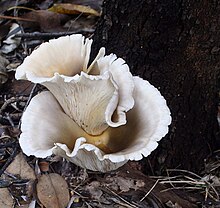
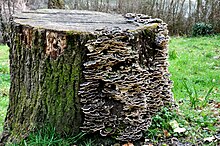

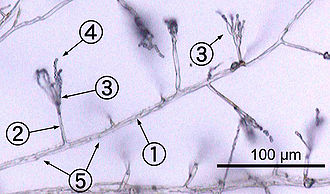
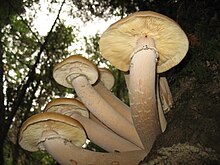

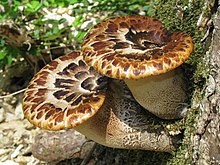

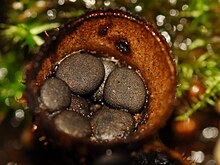




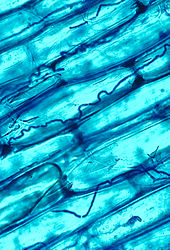
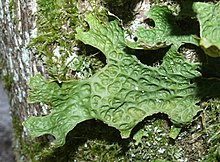
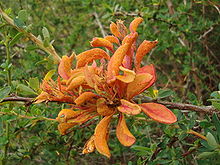
![(6aR,9R)-N-((2R,5S,10aS,10bS)-5-benzyl-10b-hydroxy-2-methyl-3,6-dioxooctahydro-2H-oxazolo[3,2-a] pyrrolo[2,1-c]pyrazin-2-yl)-7-methyl-4,6,6a,7,8,9-hexahydroindolo[4,3-fg] quinoline-9-carboxamide](https://upload.wikimedia.org/wikipedia/commons/thumb/9/94/Ergotamine3.png/220px-Ergotamine3.png)

